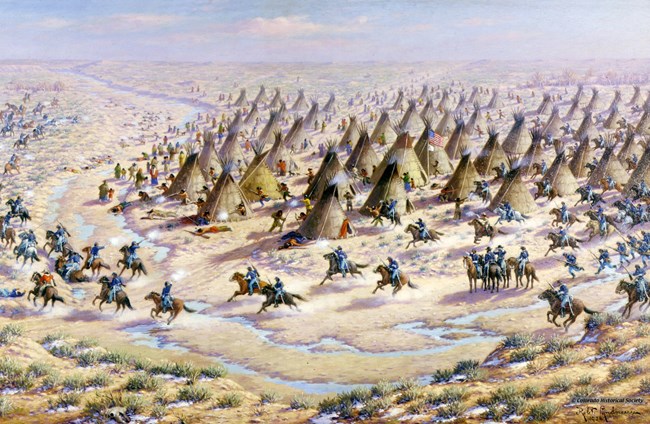
- Details
- By Levi Rickert and Neely Bardwell
THIS DAY IN HISTORY: Tuesday, November 29, 2022, is the anniversary of the Sand Creek Massacre, where approximately 230 Cheyenne & Arapaho were killed at the hands of 675 U.S. soldiers, known as the Colorado territory militia.
Among the dead on November 29, 1864 were at least 105 women, children and elders.
The soldiers were commanded by Colonel John M. Chivington to attack a village of about 750 Cheyenne and Arapaho along the Sand Creek River in Colorado.
For years, the United States had been engaged in conflict with several American Indian tribes over territory rights. The Treaty of Fort Laramie in 1851 had given the American Indians extensive territory, but the Pikes Peak gold rush in 1858 and other factors had persuaded the U.S. to renegotiate the terms of the treaty. In 1861, the Treaty of Fort Wise was signed by Southern Cheyenne and Arapaho chiefs.
The treaty took from the Southern Cheyenne and Arapaho much of the land given to them by the earlier treaty, reducing the size of their reservation to about 1/13th of the original amount.
Although the peace seeking chiefs signed the treaty to ensure the safety of their people, not all of the tribes were happy with the decision. In particular, a group of Indians known as the Dog Soldiers, made up of Cheyenne and Lakota, were vehemently opposed to having white settlers on what the Indians still referred to as their land.
The Sand Creek Massacre had a great impact on the Cheyenne and Arapaho’s traditional knowledge, language, ceremonies, and many other cultural traditions. Thirteen Cheyenne chiefs were killed, along with four Cheyenne Society Headmen and one Arapaho Chief. These individuals were these tribes’ connection to their culture and their way of life. Without these individuals, there were fewer people left to pass down traditions, language and songs.
It was another dark chapter in American history. This tragedy, and others like Wounded Knee and the Bear River Massacre, are often left out of the recollection and teaching of United States history.
It is important for the people of the United States to be aware of the tragedies inflicted upon Indigenous People that occurred at the hands of the U.S. government. This is why the Cheyenne and Arapaho people gather every year on the anniversary of the event.
The Sand Creek Massacre National Historic Site was established in 2007. In October of this year, Interior Secretary Deb Haaland (Laguna Pueblo) announced that the United States purchased nearly 3,500 acres of prairie land to expand the Sand Creek Massacre National Historic Site. Haaland and National Park Service Chuck Sams III (Umatilla) visited Sand Creek with Colorado U.S. Senators Michael Bennet (D-CO) and John Hickenlooper (D-CO). Joining the federal officials were leaders from the Northern Arapaho Tribe, the Northern Cheyenne Tribe, and the Cheyenne and Arapaho Tribes.
“We will never forget the hundreds of lives that were brutally taken here — men, women and children murdered in an unprovoked attack,” Haaland said in a written statement. “Stories like the Sand Creek Massacre are not easy to tell but it is my duty — our duty — to ensure that they are told.”
In a long overdue gesture, Colorado Gov. Jared Polis (D) in August 2021 signed an Executive Order rescinding a pair of 19th century proclamations that granted the right to kill American Indians. Polis called the two proclamations, which set the stage for the Sand Creek Massacre, "shameful."
On the Sand Creek Massacre Foundation’s website, they say: “The Sand Creek Massacre National Historic Site is the place where their spirits reside, where we come to learn, to remember, to heal, and to make sure such atrocities never happen again.”
Editor's Note: This story, originally published in 2021, has been updated to reflect Secretary Haaland's announcement and visit to the Sand Creek Massacre site in October 2022.
Help us defend tribal sovereignty.
At Native News Online, our mission is rooted in telling the stories that strengthen sovereignty and uplift Indigenous voices — not just at year’s end, but every single day.
Because of your generosity last year, we were able to keep our reporters on the ground in tribal communities, at national gatherings and in the halls of Congress — covering the issues that matter most to Indian Country: sovereignty, culture, education, health and economic opportunity.
That support sustained us through a tough year in 2025. Now, as we look to the year ahead, we need your help right now to ensure warrior journalism remains strong — reporting that defends tribal sovereignty, amplifies Native truth, and holds power accountable.
 The stakes couldn't be higher. Your support keeps Native voices heard, Native stories told and Native sovereignty defended.
The stakes couldn't be higher. Your support keeps Native voices heard, Native stories told and Native sovereignty defended.
Stand with Warrior Journalism today.
Levi Rickert (Potawatomi), Editor & Publisher
